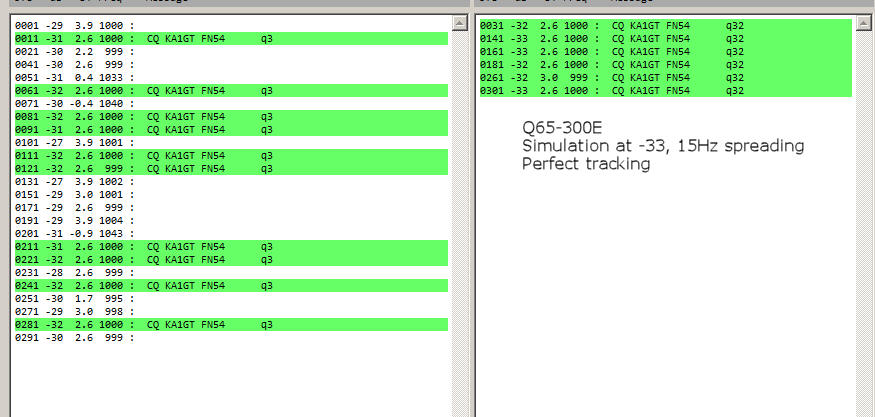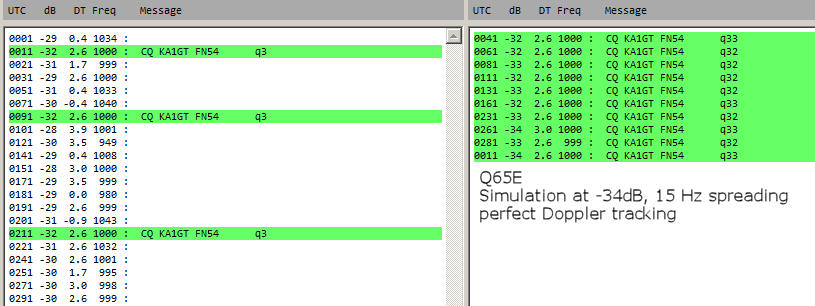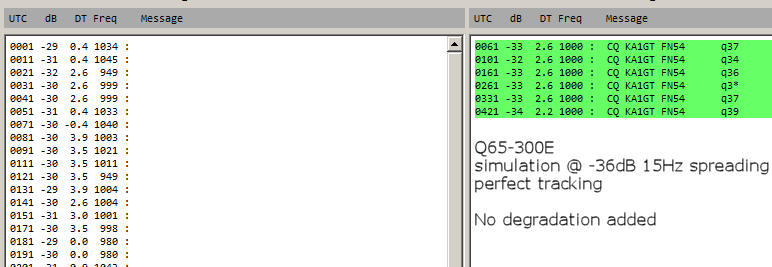300E weak signal decoding and averaging - simulation
NOTE: This page is not linked to from the index page here and has NOINXED and NOFOLLOW meta tags. It is not currently intended for public distribution. This should mean it will not be found by any web searches on the subject of Q65 or WSJT 2.4.0 (or any other subject). Even if someone else links to it (which they should not) and Google follows that link, Goggle will still not include this page it its index.
Simulation is the only practical way to look at Q65-300E performance at very low signal levels where averaging is required. With each Tx period being 5 minutes, there's a practical limit on the operators patience and the PA's durability! With shorter period modes you have the option of switching to a longer period mode, but with QT-300 you can't do that. The files created by the Q65sim program have been renamed so that all average is done on a single channel rather than alternating odd/even (or 1st/2nd)
The signals were generated using Q65sim, with a Doppler spreading of 15Hz, which is a good estimate of the effective spreading you might typically expect to see on the 1296 EME path. Perfect Doppler tracking was assumed for these simulation. The effect of 1Hz steps will be looked at, but (on the basis of other tests) is not expected to make a significant difference to the results or conclusions.
The message "CQ KAIGT FN54" was used and "KA1GT" and "FN54" were present in the DxCall and DxGrid boxes in WSJT 2.4.0-dev (10f574)
At −32dB there's about a 90% chance of a single period decode, so averaging really isn't a factor.
 Starting out at −33dB we see both single period and average decodes. There are 30 files and the chance of getting
a decode of some sort is about 50%. All the averaged decodes are 2 period decodes. This would represent a signal that is quite workable and should only need one or two transmissions to decode. Even
with a 5 minute period, this is quite practical
Starting out at −33dB we see both single period and average decodes. There are 30 files and the chance of getting
a decode of some sort is about 50%. All the averaged decodes are 2 period decodes. This would represent a signal that is quite workable and should only need one or two transmissions to decode. Even
with a 5 minute period, this is quite practical
 Going 1dB weaker to −34dB we see fewer single period decodes and more avenge decodes. The average number of files
required for a avenged decode is now 2.4. This is still quite practice for a QSO. There's still a good change you will get a decode after one or two transmissions, though it might sometimes take
3.
Going 1dB weaker to −34dB we see fewer single period decodes and more avenge decodes. The average number of files
required for a avenged decode is now 2.4. This is still quite practice for a QSO. There's still a good change you will get a decode after one or two transmissions, though it might sometimes take
3.

If we now look at signals that are 2dB weaker (−35dB) we can see that there is only one signal period decode (out of 30 files) and we have averaged decodes which require and average of 4 to 5 periods to decode. This is probably approaching (or more likely exceeds)the limit of patience of any operator, even when trying the most difficult paths.
 At −36dB we no longer see any single period decodes, but we do have 6 average decodes. The average number of .wav
files required for a decode is now 7. In practice this would take 35 minutes of continuous 5 minutes transmissions, or 1hr 10minutes of alternating transmissions.
At −36dB we no longer see any single period decodes, but we do have 6 average decodes. The average number of .wav
files required for a decode is now 7. In practice this would take 35 minutes of continuous 5 minutes transmissions, or 1hr 10minutes of alternating transmissions.
 So can we go to weaker signals with any hope of a decode (even though this is an on-air experiment few would
attempt!). The answer appears to be yes, but at −37dB we might expect to have to wait for around 13 transmissions to average before a decode is seen.
So can we go to weaker signals with any hope of a decode (even though this is an on-air experiment few would
attempt!). The answer appears to be yes, but at −37dB we might expect to have to wait for around 13 transmissions to average before a decode is seen.
 Can be go even weaker? Again, the answer is yes. This time, at −38dB and looking at 150 files, we see 4 average
decodes, requiring an average of around 35 transmissions before an average decode is made. If alternating transmissions, that's about 6 hours. Could be as little as 2 hours or as long as 12 hours
based on this simulation.
Can be go even weaker? Again, the answer is yes. This time, at −38dB and looking at 150 files, we see 4 average
decodes, requiring an average of around 35 transmissions before an average decode is made. If alternating transmissions, that's about 6 hours. Could be as little as 2 hours or as long as 12 hours
based on this simulation.
I stopped at this point as even the simulations were taking a long time!
To summarize:
-32dB - first decode most likely to be a single period AP decode
-33dB - first decode most likely to be single period decode or two period average
-34dB - first decode most likely to be a 2 (maybe 3) period average
-35dB - first decode most likely to be a 4 period average
-36dB - first decode most likely to be a 7 period average
-37dB - first decode most likely to be a 13 period average
-38dB - first decode most likely to be a 35 period
I think the point is that the averaging routine seems to be very efficient and very effective at digging even the weakest signals out of the noise - if you have the stamina to wait long enough! In practical terms, averaging can extend the useful sensitivity of QT-300 by at least 1dB and possibly 2dB beyond the point when single period decodes are most likely, and while not requiring an impossibly long wait between decodes. Unless you are trying for the first ever QSO on a new band, achieving a lower decode threshold by even longer waits and more averaging is probably not something many (of any) operators will attempt.
A similar analysis of a 30B signal at -30dB showed that, on average, 16 files were required to be averaged before a decode was observed. Comparing this to the 300E numbers, it would seem that 300E has about a 7dB greater decode sensitivity then 30B. These modes have similar, but not identical, mode spacing. 30B is 6.67Hz while 300E is 4.63 Hz. Simulated Doppler spreading in each case was 15Hz. It's unlikely that this would have a significant effect on decode sensitivity.
Bob Atkins - KA1GT
.jpg)